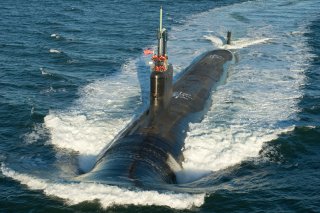The U.S. Navy's New USS Iowa Is Almost Ready for Service
The future USS Iowa is the sixth of a planned ten VCS Block IV submarines. The submarines feature Mark 48 advanced capability torpedoes and Tomahawk cruise missiles.
The lead vessel of the United States Navy's class of fast battleship, USS Iowa (BB-61) underwent much-needed TLC in the spring of 2024—although plans for the ship's relocation at the Port of Los Angeles are on hold due to costs. The historic World War II warship will hopefully be maintained for future generations, even if she will never sail again.
However, the legacy of the warship will live on: The U.S. Navy took delivery of its newest attack submarine just before Christmas. The future USS Iowa (SSN-797) also became the "12th battle force ship delivered to the Navy" in calendar year 2024, the sea service announced.
SSN-797 is now the fifth U.S. Navy vessel named for the Hawkeye state. In addition to BB-61, the prior ships included a Civil War steamboat that was used to ferry troops on the Mississippi; BB-4, a pre-dreadnought battleship that was in service during the Spanish-American War; and BB-53, a South Dakota-class battleship that was laid down after World War I but canceled due to the Washington Naval Treaty, signed in 1922.
USS Iowa: The Newest Virginia-class Submarine
The future USS Iowa is the twenty-fourth Virginia-class submarine (VCS) to be "co-produced by General Dynamics Electric Boat (GDEB) and HII-Newport News Shipbuilding through a long-standing teaming agreement and the 13th attack submarine delivered by GDEB."
"The Virginia-class submarine represents a Navy and industry commitment to deliver warfighting excellence to the fleet," said Capt. Mike Hollenbach, Virginia Class Submarine program manager. "Iowa is the second Virginia-class submarine delivered this year. With each delivery, the Navy continues to strengthen our Nation’s undersea advantage."
SSN-797 was officially christened in June 2023 at a ceremony at GDEB's shipyard in Groton, Connecticut, and the current timeline calls for the submarine's commissioning ceremony to be held on April 5, 2025, also in Groton.
Ready for Tests and Trials
With the delivery to the United States Navy, SSN-797 will be able to begin its tests and trials, which need to be completed before it is commissioned into active service.
The future USS Iowa is the sixth of a planned ten VCS Block IV submarines.
As previously reported, the Block IV boats incorporate design changes that were focused on reducing total ownership costs for the U.S. Navy. Smaller-scale design changes were made to increase the component-level lifecycle of the submarine, while the U.S. Navy was also able to increase the periodicity between depot maintenance availabilities and increase the number of deployments. The main improvement of the Block IV over the preceding Block III is the reduction of major maintenance periods from four to three, increasing each boat's total lifetime deployments by one.
The VCS Block IV submarines displace 7,835 tons, with a hull length of 377 feet and a diameter of 34 feet. Powered by an S9G nuclear reactor, the boats can attain speeds of 25 knots and remain submerged for up to three months at a time. The propulsion further employs a pump-jet system that enables quieter and more efficient movement, making the boats extremely hard to track.
Each of the Block IV subs can dive to more than 800 feet. The submarines feature Mark 48 advanced capability torpedoes and Tomahawk cruise missiles. The boats are equipped with the Virginia Payload Module, an 84-foot-long, mid-ship section that has four large-diameter, vertical launch tubes for keeping and launching more Tomahawks and other payloads.
Running Late
Even as SSN-797 is now on track to enter service in the spring of 2025, the entire VCS program is running approximately three years behind schedule.
"Part of the scheduling problem is that only two shipyards can build a U.S. Navy submarine," warned Harrison Kass, writing for The National Interest earlier in December.
Thus, even as the Navy has much to celebrate with the delivery of USS Iowa, its program is running late by several years. That problem isn't likely to be solved anytime soon.
Author Experience and Expertise: Peter Suciu
Peter Suciu is a Michigan-based writer. He has contributed to more than four dozen magazines, newspapers, and websites with over 3,200 published pieces over a twenty-year career in journalism. He regularly writes about military hardware, firearms history, cybersecurity, politics, and international affairs. Peter is also a Contributing Writer for Forbes and Clearance Jobs. You can follow him on Twitter: @PeterSuciu. You can email the author: [email protected].
Image Credit: Creative Commons and/or Shutterstock.
Image: DVIDS.

